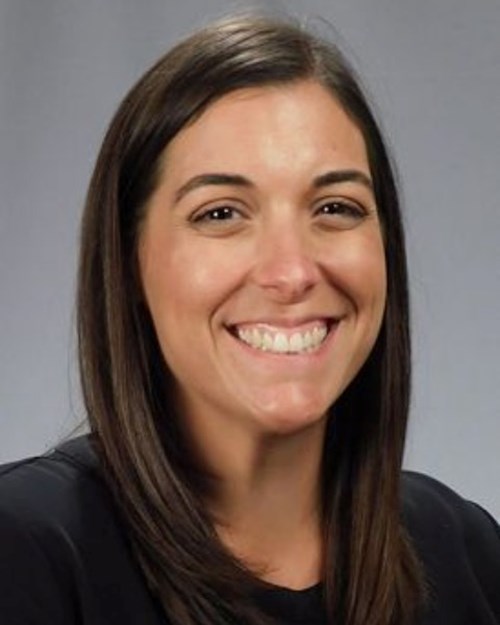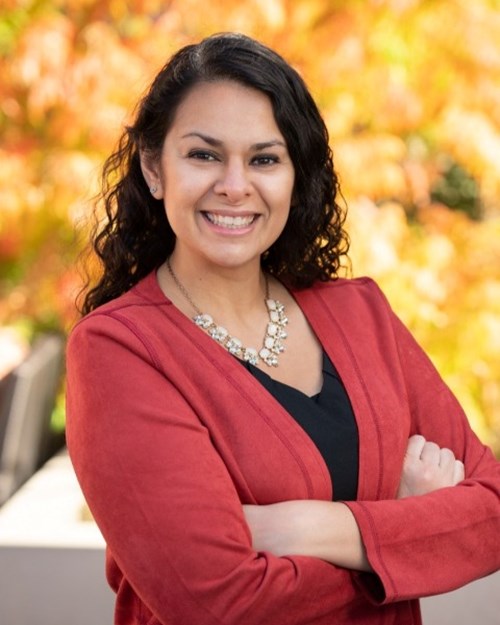
What Advanced Practitioners Need to Know About HER2 (ERBB2)-Mutant Non–Small Cell Lung Cancer: A Case-Based Approach
Case 1: Patient with newly diagnosed HER2-mutant NSCLC
Stephanie McDonald, FNP-BC, AOCNP, Narjust Florez, MD, and Sarah Tangerini, FNP-BC, discuss the treatment of a patient who is newly diagnosed with HER2 (ERBB2)-mutant non–small cell lung cancer. They review the standard first-line regimens as well as the importance of understanding the patient’s oncogenic driver in creating a treatment plan.
Chair

Stephanie McDonald, FNP-BC, AOCNP
Dana-Farber Cancer Institute
Faculty

Narjust Florez, MD
Dana-Farber Cancer Institute

Sarah Tangerini, FNP-BC
Dana-Farber Cancer Institute
Transcript
Stephanie McDonald: Welcome everybody to this virtual roundtable about HER2-mutant non-small cell lung cancer for advanced practitioners. This is a case-based approach. I'm Stephanie McDonald. I'm an oncology nurse practitioner in thoracic oncology at Dana-Farber Cancer Institute in Boston, Massachusetts. I have over 15 years’ experience in healthcare and caring for patients with cancer. Joining me today for our discussion are my fabulous colleagues, Dr. Narjust Florez, and advanced practitioner Sarah Tangerini. I'd like to begin by having my colleagues just take a minute to introduce themselves.
Dr. Narjust Florez: Hi everyone. I'm Dr. Narjust Florez, a thoracic medical oncologist. And I'm happy to be here.
Sarah Tangerini: Hey, everyone, I'm Sarah Tangerini. I'm a nurse practitioner at Dana-Farber in Boston. I work alongside Stephanie and Dr. Florez. I've been working in this department for the past three years, and prior to this, I worked in clinical research. And I am happy to be here today.
Stephanie McDonald: And I'm happy to have both of you with me, so thank you. We're going to dive into case one. This is a 44 year old non-Hispanic female, never smoker. Had some distant secondhand smoke exposure while growing up. Mother had hormonal receptor positive breast cancer at age 68. At initial presentation, the patient first presented with a chronic cough and was treated with antibiotics as well as steroids, and then was tested and the workup for COVID-19 and that was negative.
Because the patient had a persistent cough, her PCP decided to obtain a chest x-ray that showed a pulmonary mass. Examination showed decreased breath sounds bilaterally in the lower lobes and mild expiratory wheezing. Vital signs and lab work were all normal and their ECOG performance status was zero. For staging, a CT scan is typically performed. This was completed and showed a 4-cm lesion or a 40-mm lesion in the upper lobe of the left lung, and multiple bilateral small nodules in the entire lung field.
And then, a brain MRI, which is part of our staging workup, was completed as well. And this showed more than 20 multiple asymptomatic brain metastasis with a maximum diameter about 12 millimeters. I think it's important here to mention, as Dr. Florez mentioned in the introduction, that brain lesions are common in HER2 patients, and HER2 patients are more likely to have brain metastasis at presentation.
Low and behold, the patient had a bronch biopsy, a bronchoscopy guided biopsy, of one of the lung nodules, and this revealed mucus adenocarcinoma. It was TTF positive with micro papillary involvement, and the PD-L1 testing came back as 60%. This patient had a liquid biopsy and it was positive for a HER2 mutation. With that information, Dr. Florez, is that enough to start treatment? How does that information guide your decision, when you walk in you see that patient and you're reviewing their case with them and making a treatment plan?
Dr. Narjust Florez: The first thing that comes to mind when you see a patient like this is, one, don't get too excited about the PD-L1 in a patient with a HER2 mutation. These patients are less likely to respond to [...] Despite having a high PD-L1, remember chemotherapy is still important for these patients. And two, we have the liquid biopsy that shows that. You can start treatment, but it's important to confirm the diagnosis with tissue. Gold standard. The tissue is still the issue. You can start as early [...] By the time you get the [...] in the schedule, I think liquid biopsies allow you to move things forward.
And very important is the brain lesions. Make sure the patient is asymptomatic. Brain lesions need to be treated before they start treatment, because chemotherapy and brain radiation is too toxic together. And finally, are there clinical trials that the patient can go on instead of standard care?
Stephanie McDonald: Thank you. And just to review, did you say if they have symptomatic brain metastasis or asymptomatic brain metastasis that they're getting that they need to be addressed first? Is it typically-
Dr. Narjust Florez: Symptomatic brain metastasis, and sometimes patients may have limbic metastasis that can ... with quick instead of tactic radiation?
Stephanie McDonald: Yep.
Dr. Narjust Florez: So having the discussion and involving radiation oncology is important. That's what why cannot do this job alone. We need every member of the team. And it's good to have the radiation oncology on speed dial for-
Stephanie McDonald: Absolutely. We do that all the time. It's just that it gets back to, this is a team-based approach and I think we definitely rely on each other as advanced practitioners, our physician colleagues, and the other members of the healthcare team and other specialties to work together to provide specialized care for these patients.
Because they might have a similar or same presentation or HER2 mutation, but every cancer is treated a little differently and everybody is treated individually. Their case is a little different and needs special attention. Thank you. And Sarah, I do have a question for you. What are the challenges in treating patients with HER2 mutant non-small cell lung cancer?
Sarah Tangerini: Sure. Although our patients with HER2 mutant non-small cell lung cancer have an actionable biomarker, it is still recommended that first line treatment is standard of care: platinum based chemotherapy, sometimes with immunotherapy. This can be difficult for patients to understand, why they're not receiving a targeted therapy as first line treatment. For example, in our patients with EGFR mutant lung cancer, they are first line put on Tagrisso, which is an oral therapy.
It's difficult for our patients with HER2 mutant non-small cell lung cancer to understand why they wouldn't receive a targeted therapy for their first line treatment. It's also important for the NP to explain why chemo is used as first line treatments, and then to also provide additional support systems that the patients can use throughout their treatment such as social work and palliative care. It's really important to get these additional support systems involved early on in treatment so that patients feel supported in all aspects of their care.
Stephanie McDonald: Thank you. Dr. Florez, do you find that to be a difficult conversation with patients, when they come in and they've maybe done their own research or now that there's access to patient's charts and they can see these mutations, they can see their pathology? I think this is its own evolution, that patients can see their own medical records and be able to see, sometimes, these mutations or these pathology results before they meet with you and have all these questions.
Something like this where maybe they do their own research and see that, especially now, that there's trastuzumab deruxtecan targeted therapy for these HER2 mutations. How do you address that with patients and give them reassurance or guidance when they're coming in and wondering why they're not getting started right away on this targeted therapy, and they're being guided towards this standard of care?
Dr. Narjust Florez: […] is to ask patients, what is their understanding? To know what they really know. I come the principles of culture of humility, which is lifelong learner. I always learn what they know. And then I ask, what are your worries about standard of care? When you get their worries, then you're able to address it as specific. Because some patients are very worried about chemotherapy, and they see chemotherapy ... They had a patient, a friend, a neighbor, a family member that got breast cancer, and that chemotherapy is quite different than the one that we use.
What is their knowledge base? And also, I explained that the trial of the drug has not been studied in this setting, so it's not safe. And that's what is safe in the first line setting. And finally, we have to be honest. The insurance will not cover it. So then, this new fancy drug, it is a new fancy drug so it comes with a very high price tag.
Stephanie McDonald: Thank you. I think it's important to be able to have these discussions with our patients, and as the advanced practitioner, to be able to have a good understanding of this as well. Because sometimes, we're leading these discussions as well. And I know in our clinic, we implement chemotherapy teaching sessions with patients when they're going to be started on any kind of therapy, systemic or targeted therapy.
I think having a good understanding of why one regimen is chosen over another and really understanding that will help us to support our patients the best that we can. Thank you for that explanation.
Dr. Narjust Florez: Stephanie, I'm just going to ask something quick. And it's that patients feel more comfortable with advanced practitioners, so they ask some real questions that sometimes they don't ask me. And that's why having good communication with your nurse practitioner or physician assistant is so important. We are here together but we communicate. My patients told you something, Stephanie, they would never tell me. I think communication is important to address patient's fears, concerns, at all levels.
Stephanie McDonald: I agree. How many times do you see that? I think that it's so important for a team-based approach. I can't express that enough. And I know in our clinic, I don't know if it's biased, but I've worked in other institutions. I think it is key to the patient care is good communication with your team members, your other advanced practitioners, talking things out, your physician colleagues. And really getting a good understanding and communicating really helps contribute to the patient outcomes. Thank you guys so much.
Just a couple of key clinical takeaways from this. It's important to understand the patient's oncogenic driver. Specific mutation does matter, and it's going to drive your treatment and lead to better outcomes and probably possibly contribute to a decrease in some toxicities related to treatment depending on what they're going to be getting.
And even though a patient has a HER2 mutation, first line remains that platinum-based therapy before pursuing HER2 directed therapy. That standard of care, first line for advanced non-small cell lung cancer is, again, that platinum based double chemo plus immunotherapy. Either carboplatin or cisplatin, plus pemetrexed, plus pembrolizumab. That would be the standard of care. And this information may be challenging or distressing to a patient and their family, and there are supports for that. And the key, like we talked about, is good communication with your team and the patients to get a really good understanding of, again, what their understanding is and what their fears are going into this.
Also, taking into the consideration those financial concerns, absolutely. Dr. Florez, I know that's a small piece of, and a realistic, piece of the pie. And some clinical trials are testing HER2 therapy in first line and it could be an option for patients. This brings us to the end of this case. Please see the other segments for further discussion about HER2 mutant non-small cell lung cancer or visit advancedpractitioner.com. Thank you.
